7BSP0355 Coursework 2: AstraZeneca Strategic Analysis and Solutions
VerifiedAdded on 2022/09/25
|10
|2394
|16
Report
AI Summary
This report offers a detailed strategic analysis of the pharmaceutical company AstraZeneca, examining its internal and external environments. It utilizes outside-in and inside-out analytical frameworks to identify strategic issues across short, medium, and long-term horizons. A SWOT analysis is conducted to evaluate the company's strengths, weaknesses, opportunities, and threats. The report identifies key strategic issues, such as the lack of shareholder understanding and the dominance of UK corporate governance, and proposes solutions like the integration of a corporate hub governance model to align stakeholders and foster innovation. The analysis considers the impact of these issues on the company's ability to innovate, compete, and achieve long-term success in the pharmaceutical industry, emphasizing the need for improved communication, stakeholder engagement, and a focus on long-term value creation.
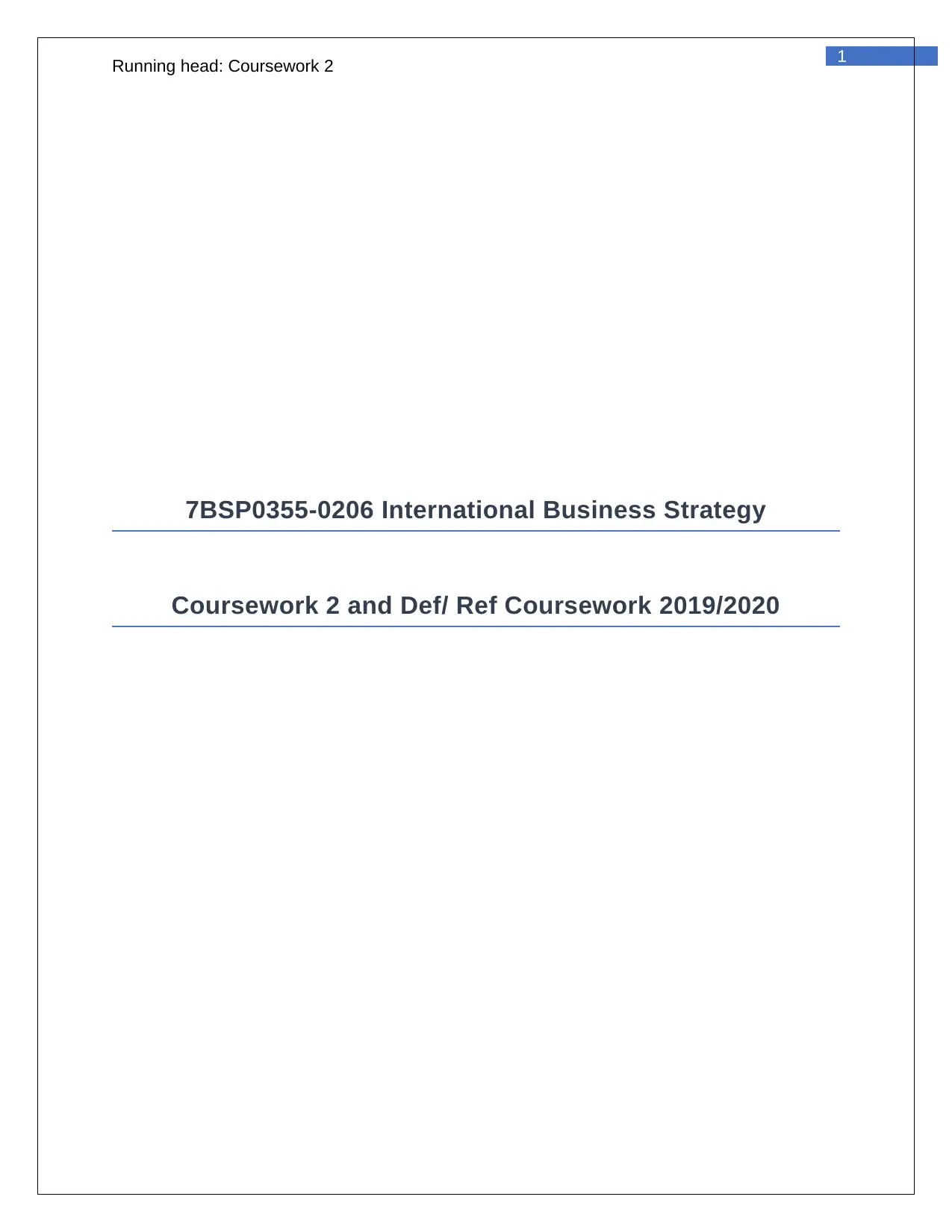
11
Running head: Coursework 2
7BSP0355-0206 International Business Strategy
Coursework 2 and Def/ Ref Coursework 2019/2020
Running head: Coursework 2
7BSP0355-0206 International Business Strategy
Coursework 2 and Def/ Ref Coursework 2019/2020
Paraphrase This Document
Need a fresh take? Get an instant paraphrase of this document with our AI Paraphraser
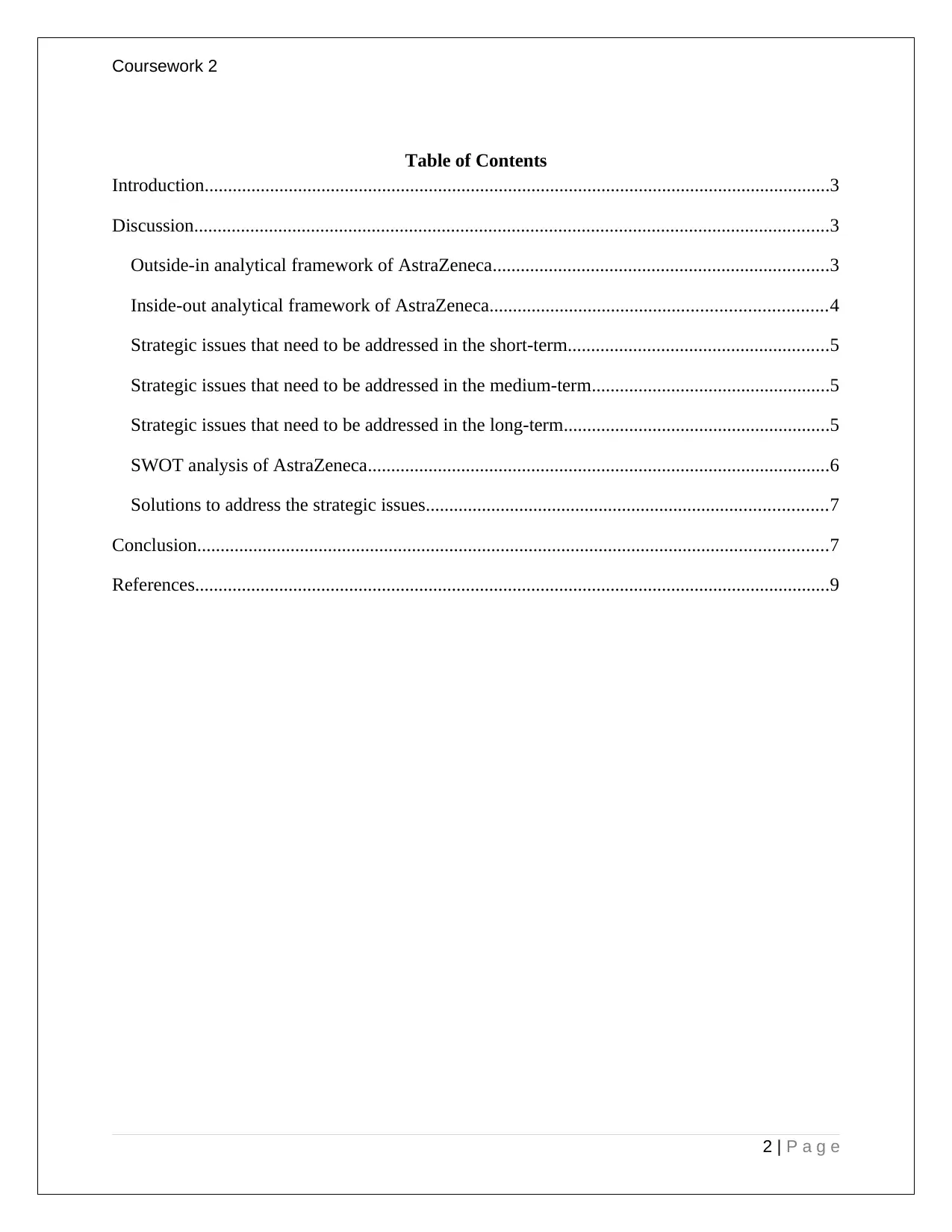
Coursework 2
Table of Contents
Introduction......................................................................................................................................3
Discussion........................................................................................................................................3
Outside-in analytical framework of AstraZeneca........................................................................3
Inside-out analytical framework of AstraZeneca........................................................................4
Strategic issues that need to be addressed in the short-term........................................................5
Strategic issues that need to be addressed in the medium-term...................................................5
Strategic issues that need to be addressed in the long-term.........................................................5
SWOT analysis of AstraZeneca...................................................................................................6
Solutions to address the strategic issues......................................................................................7
Conclusion.......................................................................................................................................7
References........................................................................................................................................9
2 | P a g e
Table of Contents
Introduction......................................................................................................................................3
Discussion........................................................................................................................................3
Outside-in analytical framework of AstraZeneca........................................................................3
Inside-out analytical framework of AstraZeneca........................................................................4
Strategic issues that need to be addressed in the short-term........................................................5
Strategic issues that need to be addressed in the medium-term...................................................5
Strategic issues that need to be addressed in the long-term.........................................................5
SWOT analysis of AstraZeneca...................................................................................................6
Solutions to address the strategic issues......................................................................................7
Conclusion.......................................................................................................................................7
References........................................................................................................................................9
2 | P a g e
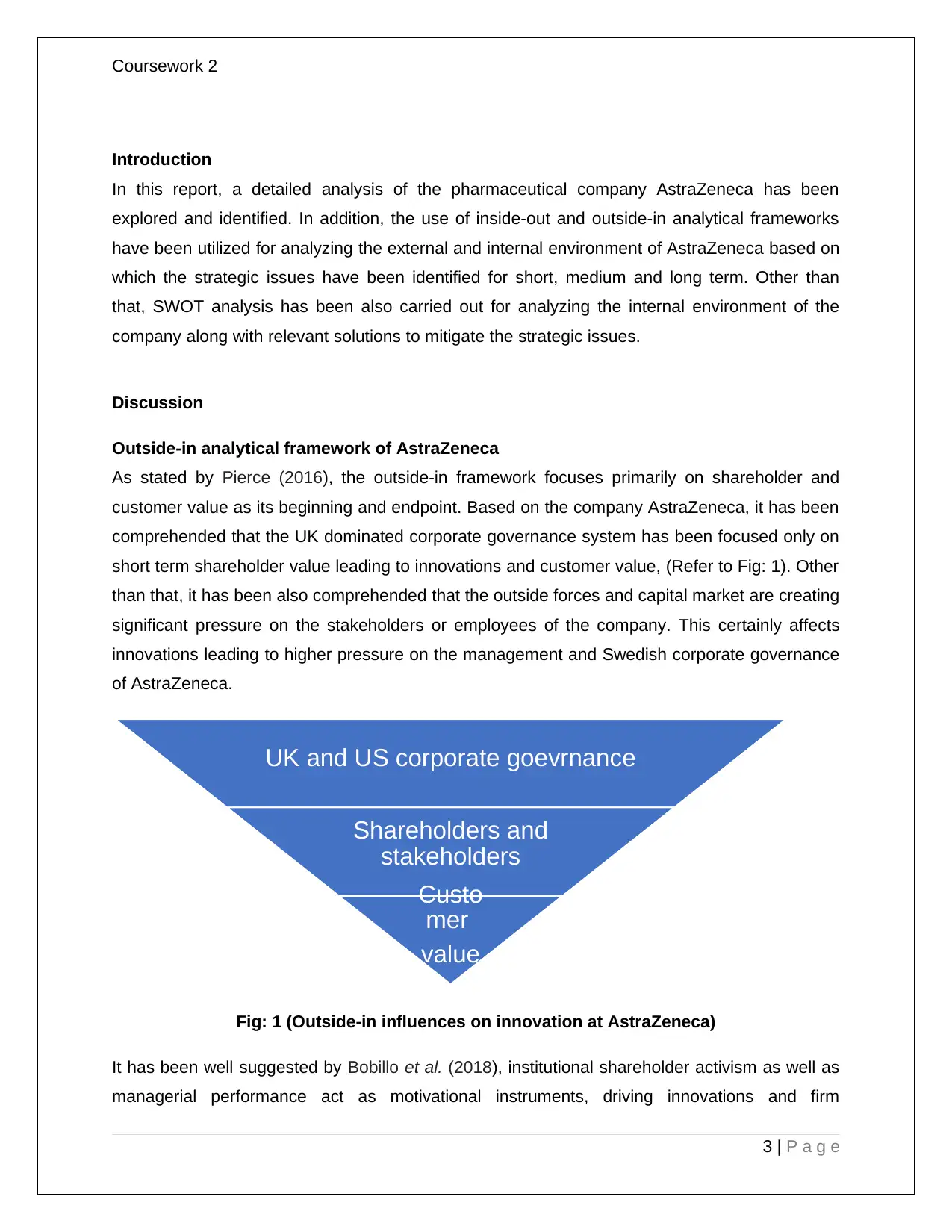
Coursework 2
Introduction
In this report, a detailed analysis of the pharmaceutical company AstraZeneca has been
explored and identified. In addition, the use of inside-out and outside-in analytical frameworks
have been utilized for analyzing the external and internal environment of AstraZeneca based on
which the strategic issues have been identified for short, medium and long term. Other than
that, SWOT analysis has been also carried out for analyzing the internal environment of the
company along with relevant solutions to mitigate the strategic issues.
Discussion
Outside-in analytical framework of AstraZeneca
As stated by Pierce (2016), the outside-in framework focuses primarily on shareholder and
customer value as its beginning and endpoint. Based on the company AstraZeneca, it has been
comprehended that the UK dominated corporate governance system has been focused only on
short term shareholder value leading to innovations and customer value, (Refer to Fig: 1). Other
than that, it has been also comprehended that the outside forces and capital market are creating
significant pressure on the stakeholders or employees of the company. This certainly affects
innovations leading to higher pressure on the management and Swedish corporate governance
of AstraZeneca.
Fig: 1 (Outside-in influences on innovation at AstraZeneca)
It has been well suggested by Bobillo et al. (2018), institutional shareholder activism as well as
managerial performance act as motivational instruments, driving innovations and firm
3 | P a g e
UK and US corporate goevrnance
Shareholders and
stakeholders
Custo
mer
value
Introduction
In this report, a detailed analysis of the pharmaceutical company AstraZeneca has been
explored and identified. In addition, the use of inside-out and outside-in analytical frameworks
have been utilized for analyzing the external and internal environment of AstraZeneca based on
which the strategic issues have been identified for short, medium and long term. Other than
that, SWOT analysis has been also carried out for analyzing the internal environment of the
company along with relevant solutions to mitigate the strategic issues.
Discussion
Outside-in analytical framework of AstraZeneca
As stated by Pierce (2016), the outside-in framework focuses primarily on shareholder and
customer value as its beginning and endpoint. Based on the company AstraZeneca, it has been
comprehended that the UK dominated corporate governance system has been focused only on
short term shareholder value leading to innovations and customer value, (Refer to Fig: 1). Other
than that, it has been also comprehended that the outside forces and capital market are creating
significant pressure on the stakeholders or employees of the company. This certainly affects
innovations leading to higher pressure on the management and Swedish corporate governance
of AstraZeneca.
Fig: 1 (Outside-in influences on innovation at AstraZeneca)
It has been well suggested by Bobillo et al. (2018), institutional shareholder activism as well as
managerial performance act as motivational instruments, driving innovations and firm
3 | P a g e
UK and US corporate goevrnance
Shareholders and
stakeholders
Custo
mer
value
⊘ This is a preview!⊘
Do you want full access?
Subscribe today to unlock all pages.

Trusted by 1+ million students worldwide
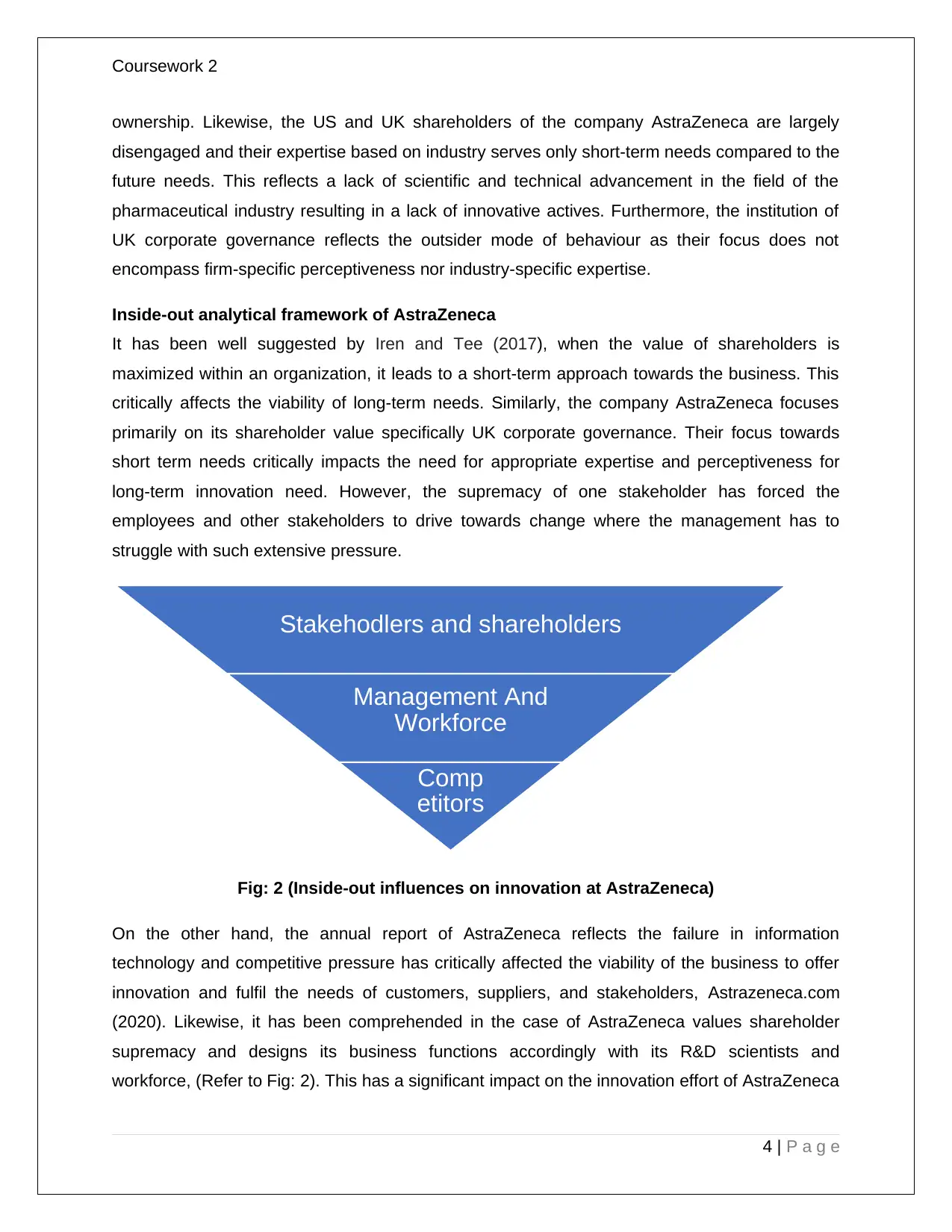
Coursework 2
ownership. Likewise, the US and UK shareholders of the company AstraZeneca are largely
disengaged and their expertise based on industry serves only short-term needs compared to the
future needs. This reflects a lack of scientific and technical advancement in the field of the
pharmaceutical industry resulting in a lack of innovative actives. Furthermore, the institution of
UK corporate governance reflects the outsider mode of behaviour as their focus does not
encompass firm-specific perceptiveness nor industry-specific expertise.
Inside-out analytical framework of AstraZeneca
It has been well suggested by Iren and Tee (2017), when the value of shareholders is
maximized within an organization, it leads to a short-term approach towards the business. This
critically affects the viability of long-term needs. Similarly, the company AstraZeneca focuses
primarily on its shareholder value specifically UK corporate governance. Their focus towards
short term needs critically impacts the need for appropriate expertise and perceptiveness for
long-term innovation need. However, the supremacy of one stakeholder has forced the
employees and other stakeholders to drive towards change where the management has to
struggle with such extensive pressure.
Fig: 2 (Inside-out influences on innovation at AstraZeneca)
On the other hand, the annual report of AstraZeneca reflects the failure in information
technology and competitive pressure has critically affected the viability of the business to offer
innovation and fulfil the needs of customers, suppliers, and stakeholders, Astrazeneca.com
(2020). Likewise, it has been comprehended in the case of AstraZeneca values shareholder
supremacy and designs its business functions accordingly with its R&D scientists and
workforce, (Refer to Fig: 2). This has a significant impact on the innovation effort of AstraZeneca
4 | P a g e
Stakehodlers and shareholders
Management And
Workforce
Comp
etitors
ownership. Likewise, the US and UK shareholders of the company AstraZeneca are largely
disengaged and their expertise based on industry serves only short-term needs compared to the
future needs. This reflects a lack of scientific and technical advancement in the field of the
pharmaceutical industry resulting in a lack of innovative actives. Furthermore, the institution of
UK corporate governance reflects the outsider mode of behaviour as their focus does not
encompass firm-specific perceptiveness nor industry-specific expertise.
Inside-out analytical framework of AstraZeneca
It has been well suggested by Iren and Tee (2017), when the value of shareholders is
maximized within an organization, it leads to a short-term approach towards the business. This
critically affects the viability of long-term needs. Similarly, the company AstraZeneca focuses
primarily on its shareholder value specifically UK corporate governance. Their focus towards
short term needs critically impacts the need for appropriate expertise and perceptiveness for
long-term innovation need. However, the supremacy of one stakeholder has forced the
employees and other stakeholders to drive towards change where the management has to
struggle with such extensive pressure.
Fig: 2 (Inside-out influences on innovation at AstraZeneca)
On the other hand, the annual report of AstraZeneca reflects the failure in information
technology and competitive pressure has critically affected the viability of the business to offer
innovation and fulfil the needs of customers, suppliers, and stakeholders, Astrazeneca.com
(2020). Likewise, it has been comprehended in the case of AstraZeneca values shareholder
supremacy and designs its business functions accordingly with its R&D scientists and
workforce, (Refer to Fig: 2). This has a significant impact on the innovation effort of AstraZeneca
4 | P a g e
Stakehodlers and shareholders
Management And
Workforce
Comp
etitors
Paraphrase This Document
Need a fresh take? Get an instant paraphrase of this document with our AI Paraphraser
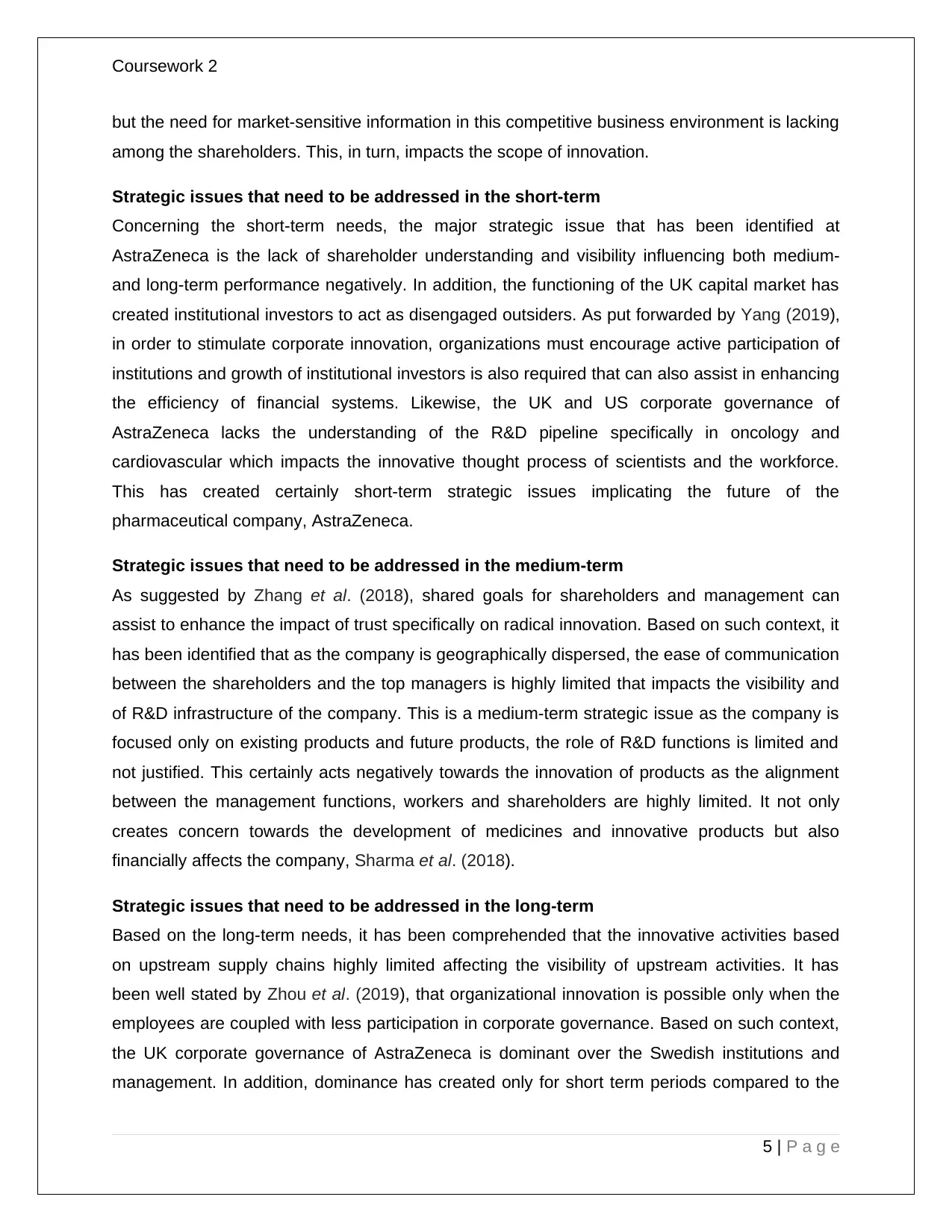
Coursework 2
but the need for market-sensitive information in this competitive business environment is lacking
among the shareholders. This, in turn, impacts the scope of innovation.
Strategic issues that need to be addressed in the short-term
Concerning the short-term needs, the major strategic issue that has been identified at
AstraZeneca is the lack of shareholder understanding and visibility influencing both medium-
and long-term performance negatively. In addition, the functioning of the UK capital market has
created institutional investors to act as disengaged outsiders. As put forwarded by Yang (2019),
in order to stimulate corporate innovation, organizations must encourage active participation of
institutions and growth of institutional investors is also required that can also assist in enhancing
the efficiency of financial systems. Likewise, the UK and US corporate governance of
AstraZeneca lacks the understanding of the R&D pipeline specifically in oncology and
cardiovascular which impacts the innovative thought process of scientists and the workforce.
This has created certainly short-term strategic issues implicating the future of the
pharmaceutical company, AstraZeneca.
Strategic issues that need to be addressed in the medium-term
As suggested by Zhang et al. (2018), shared goals for shareholders and management can
assist to enhance the impact of trust specifically on radical innovation. Based on such context, it
has been identified that as the company is geographically dispersed, the ease of communication
between the shareholders and the top managers is highly limited that impacts the visibility and
of R&D infrastructure of the company. This is a medium-term strategic issue as the company is
focused only on existing products and future products, the role of R&D functions is limited and
not justified. This certainly acts negatively towards the innovation of products as the alignment
between the management functions, workers and shareholders are highly limited. It not only
creates concern towards the development of medicines and innovative products but also
financially affects the company, Sharma et al. (2018).
Strategic issues that need to be addressed in the long-term
Based on the long-term needs, it has been comprehended that the innovative activities based
on upstream supply chains highly limited affecting the visibility of upstream activities. It has
been well stated by Zhou et al. (2019), that organizational innovation is possible only when the
employees are coupled with less participation in corporate governance. Based on such context,
the UK corporate governance of AstraZeneca is dominant over the Swedish institutions and
management. In addition, dominance has created only for short term periods compared to the
5 | P a g e
but the need for market-sensitive information in this competitive business environment is lacking
among the shareholders. This, in turn, impacts the scope of innovation.
Strategic issues that need to be addressed in the short-term
Concerning the short-term needs, the major strategic issue that has been identified at
AstraZeneca is the lack of shareholder understanding and visibility influencing both medium-
and long-term performance negatively. In addition, the functioning of the UK capital market has
created institutional investors to act as disengaged outsiders. As put forwarded by Yang (2019),
in order to stimulate corporate innovation, organizations must encourage active participation of
institutions and growth of institutional investors is also required that can also assist in enhancing
the efficiency of financial systems. Likewise, the UK and US corporate governance of
AstraZeneca lacks the understanding of the R&D pipeline specifically in oncology and
cardiovascular which impacts the innovative thought process of scientists and the workforce.
This has created certainly short-term strategic issues implicating the future of the
pharmaceutical company, AstraZeneca.
Strategic issues that need to be addressed in the medium-term
As suggested by Zhang et al. (2018), shared goals for shareholders and management can
assist to enhance the impact of trust specifically on radical innovation. Based on such context, it
has been identified that as the company is geographically dispersed, the ease of communication
between the shareholders and the top managers is highly limited that impacts the visibility and
of R&D infrastructure of the company. This is a medium-term strategic issue as the company is
focused only on existing products and future products, the role of R&D functions is limited and
not justified. This certainly acts negatively towards the innovation of products as the alignment
between the management functions, workers and shareholders are highly limited. It not only
creates concern towards the development of medicines and innovative products but also
financially affects the company, Sharma et al. (2018).
Strategic issues that need to be addressed in the long-term
Based on the long-term needs, it has been comprehended that the innovative activities based
on upstream supply chains highly limited affecting the visibility of upstream activities. It has
been well stated by Zhou et al. (2019), that organizational innovation is possible only when the
employees are coupled with less participation in corporate governance. Based on such context,
the UK corporate governance of AstraZeneca is dominant over the Swedish institutions and
management. In addition, dominance has created only for short term periods compared to the
5 | P a g e
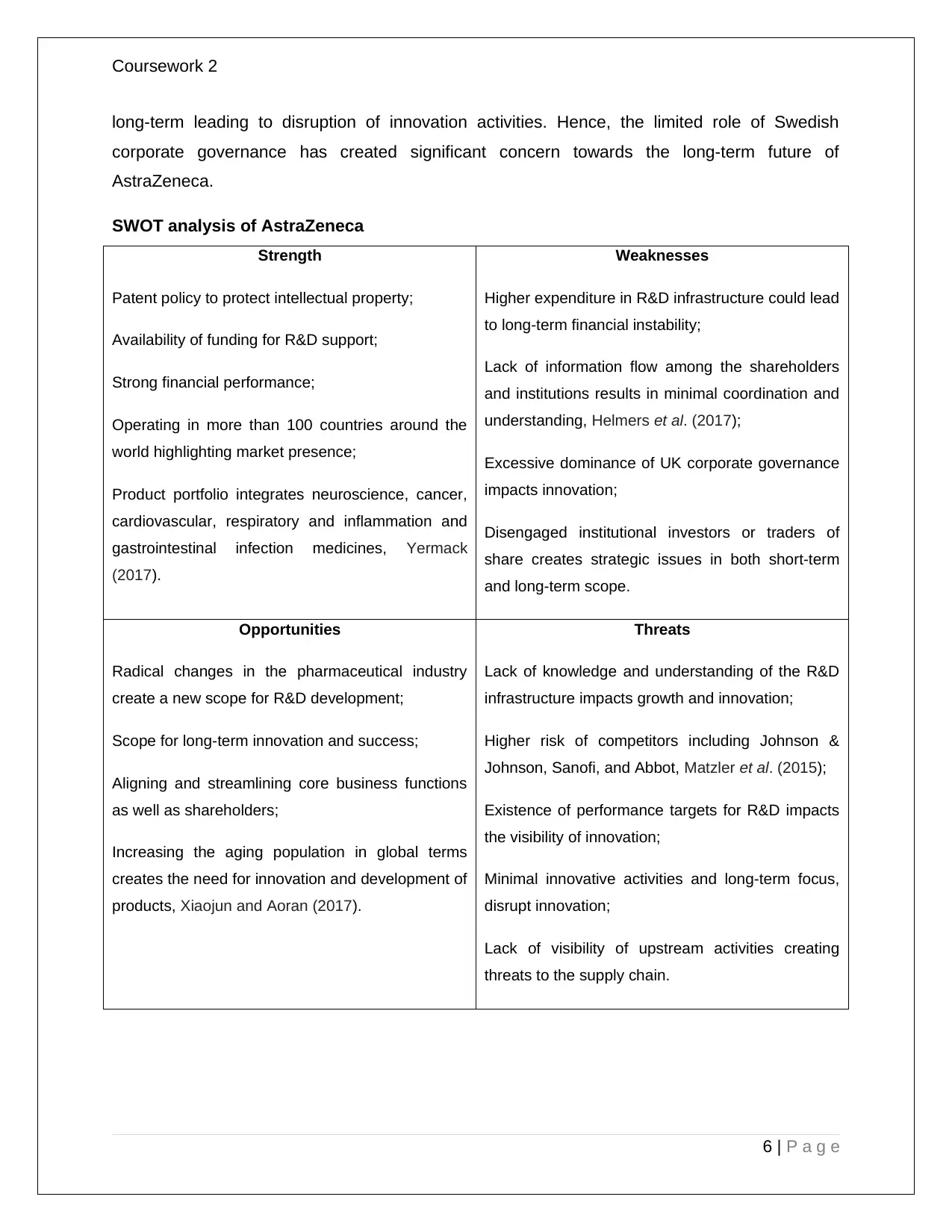
Coursework 2
long-term leading to disruption of innovation activities. Hence, the limited role of Swedish
corporate governance has created significant concern towards the long-term future of
AstraZeneca.
SWOT analysis of AstraZeneca
Strength
Patent policy to protect intellectual property;
Availability of funding for R&D support;
Strong financial performance;
Operating in more than 100 countries around the
world highlighting market presence;
Product portfolio integrates neuroscience, cancer,
cardiovascular, respiratory and inflammation and
gastrointestinal infection medicines, Yermack
(2017).
Weaknesses
Higher expenditure in R&D infrastructure could lead
to long-term financial instability;
Lack of information flow among the shareholders
and institutions results in minimal coordination and
understanding, Helmers et al. (2017);
Excessive dominance of UK corporate governance
impacts innovation;
Disengaged institutional investors or traders of
share creates strategic issues in both short-term
and long-term scope.
Opportunities
Radical changes in the pharmaceutical industry
create a new scope for R&D development;
Scope for long-term innovation and success;
Aligning and streamlining core business functions
as well as shareholders;
Increasing the aging population in global terms
creates the need for innovation and development of
products, Xiaojun and Aoran (2017).
Threats
Lack of knowledge and understanding of the R&D
infrastructure impacts growth and innovation;
Higher risk of competitors including Johnson &
Johnson, Sanofi, and Abbot, Matzler et al. (2015);
Existence of performance targets for R&D impacts
the visibility of innovation;
Minimal innovative activities and long-term focus,
disrupt innovation;
Lack of visibility of upstream activities creating
threats to the supply chain.
6 | P a g e
long-term leading to disruption of innovation activities. Hence, the limited role of Swedish
corporate governance has created significant concern towards the long-term future of
AstraZeneca.
SWOT analysis of AstraZeneca
Strength
Patent policy to protect intellectual property;
Availability of funding for R&D support;
Strong financial performance;
Operating in more than 100 countries around the
world highlighting market presence;
Product portfolio integrates neuroscience, cancer,
cardiovascular, respiratory and inflammation and
gastrointestinal infection medicines, Yermack
(2017).
Weaknesses
Higher expenditure in R&D infrastructure could lead
to long-term financial instability;
Lack of information flow among the shareholders
and institutions results in minimal coordination and
understanding, Helmers et al. (2017);
Excessive dominance of UK corporate governance
impacts innovation;
Disengaged institutional investors or traders of
share creates strategic issues in both short-term
and long-term scope.
Opportunities
Radical changes in the pharmaceutical industry
create a new scope for R&D development;
Scope for long-term innovation and success;
Aligning and streamlining core business functions
as well as shareholders;
Increasing the aging population in global terms
creates the need for innovation and development of
products, Xiaojun and Aoran (2017).
Threats
Lack of knowledge and understanding of the R&D
infrastructure impacts growth and innovation;
Higher risk of competitors including Johnson &
Johnson, Sanofi, and Abbot, Matzler et al. (2015);
Existence of performance targets for R&D impacts
the visibility of innovation;
Minimal innovative activities and long-term focus,
disrupt innovation;
Lack of visibility of upstream activities creating
threats to the supply chain.
6 | P a g e
⊘ This is a preview!⊘
Do you want full access?
Subscribe today to unlock all pages.

Trusted by 1+ million students worldwide
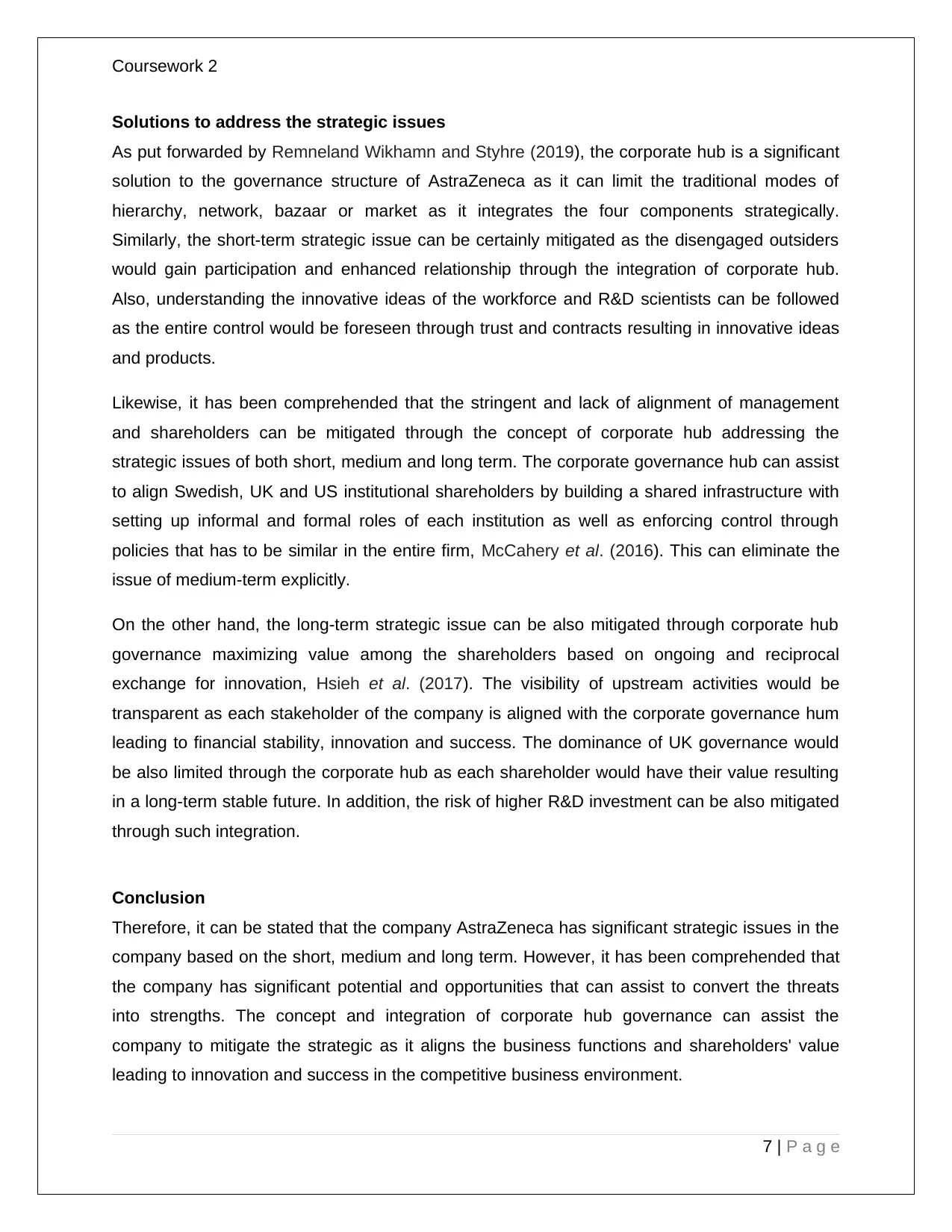
Coursework 2
Solutions to address the strategic issues
As put forwarded by Remneland Wikhamn and Styhre (2019), the corporate hub is a significant
solution to the governance structure of AstraZeneca as it can limit the traditional modes of
hierarchy, network, bazaar or market as it integrates the four components strategically.
Similarly, the short-term strategic issue can be certainly mitigated as the disengaged outsiders
would gain participation and enhanced relationship through the integration of corporate hub.
Also, understanding the innovative ideas of the workforce and R&D scientists can be followed
as the entire control would be foreseen through trust and contracts resulting in innovative ideas
and products.
Likewise, it has been comprehended that the stringent and lack of alignment of management
and shareholders can be mitigated through the concept of corporate hub addressing the
strategic issues of both short, medium and long term. The corporate governance hub can assist
to align Swedish, UK and US institutional shareholders by building a shared infrastructure with
setting up informal and formal roles of each institution as well as enforcing control through
policies that has to be similar in the entire firm, McCahery et al. (2016). This can eliminate the
issue of medium-term explicitly.
On the other hand, the long-term strategic issue can be also mitigated through corporate hub
governance maximizing value among the shareholders based on ongoing and reciprocal
exchange for innovation, Hsieh et al. (2017). The visibility of upstream activities would be
transparent as each stakeholder of the company is aligned with the corporate governance hum
leading to financial stability, innovation and success. The dominance of UK governance would
be also limited through the corporate hub as each shareholder would have their value resulting
in a long-term stable future. In addition, the risk of higher R&D investment can be also mitigated
through such integration.
Conclusion
Therefore, it can be stated that the company AstraZeneca has significant strategic issues in the
company based on the short, medium and long term. However, it has been comprehended that
the company has significant potential and opportunities that can assist to convert the threats
into strengths. The concept and integration of corporate hub governance can assist the
company to mitigate the strategic as it aligns the business functions and shareholders' value
leading to innovation and success in the competitive business environment.
7 | P a g e
Solutions to address the strategic issues
As put forwarded by Remneland Wikhamn and Styhre (2019), the corporate hub is a significant
solution to the governance structure of AstraZeneca as it can limit the traditional modes of
hierarchy, network, bazaar or market as it integrates the four components strategically.
Similarly, the short-term strategic issue can be certainly mitigated as the disengaged outsiders
would gain participation and enhanced relationship through the integration of corporate hub.
Also, understanding the innovative ideas of the workforce and R&D scientists can be followed
as the entire control would be foreseen through trust and contracts resulting in innovative ideas
and products.
Likewise, it has been comprehended that the stringent and lack of alignment of management
and shareholders can be mitigated through the concept of corporate hub addressing the
strategic issues of both short, medium and long term. The corporate governance hub can assist
to align Swedish, UK and US institutional shareholders by building a shared infrastructure with
setting up informal and formal roles of each institution as well as enforcing control through
policies that has to be similar in the entire firm, McCahery et al. (2016). This can eliminate the
issue of medium-term explicitly.
On the other hand, the long-term strategic issue can be also mitigated through corporate hub
governance maximizing value among the shareholders based on ongoing and reciprocal
exchange for innovation, Hsieh et al. (2017). The visibility of upstream activities would be
transparent as each stakeholder of the company is aligned with the corporate governance hum
leading to financial stability, innovation and success. The dominance of UK governance would
be also limited through the corporate hub as each shareholder would have their value resulting
in a long-term stable future. In addition, the risk of higher R&D investment can be also mitigated
through such integration.
Conclusion
Therefore, it can be stated that the company AstraZeneca has significant strategic issues in the
company based on the short, medium and long term. However, it has been comprehended that
the company has significant potential and opportunities that can assist to convert the threats
into strengths. The concept and integration of corporate hub governance can assist the
company to mitigate the strategic as it aligns the business functions and shareholders' value
leading to innovation and success in the competitive business environment.
7 | P a g e
Paraphrase This Document
Need a fresh take? Get an instant paraphrase of this document with our AI Paraphraser
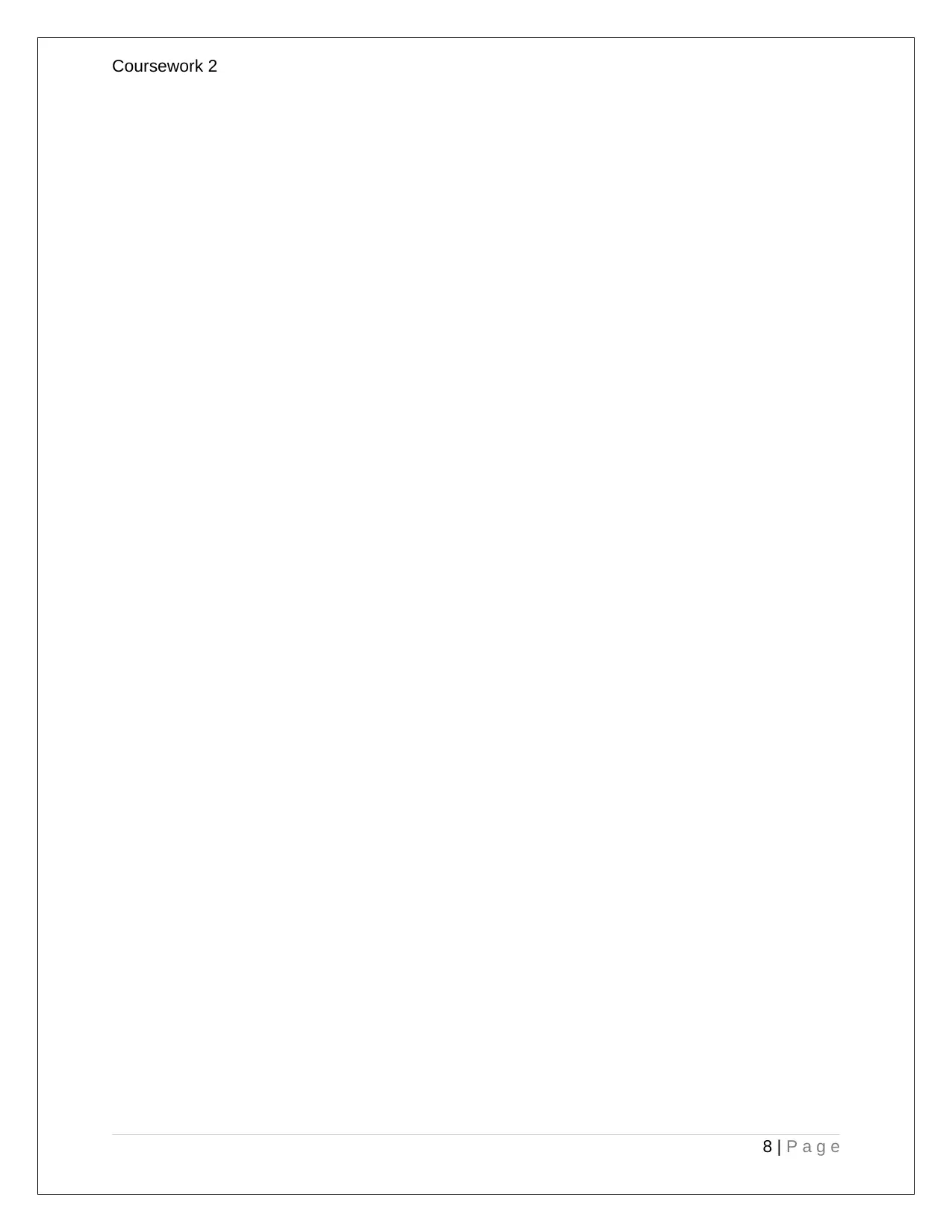
Coursework 2
8 | P a g e
8 | P a g e
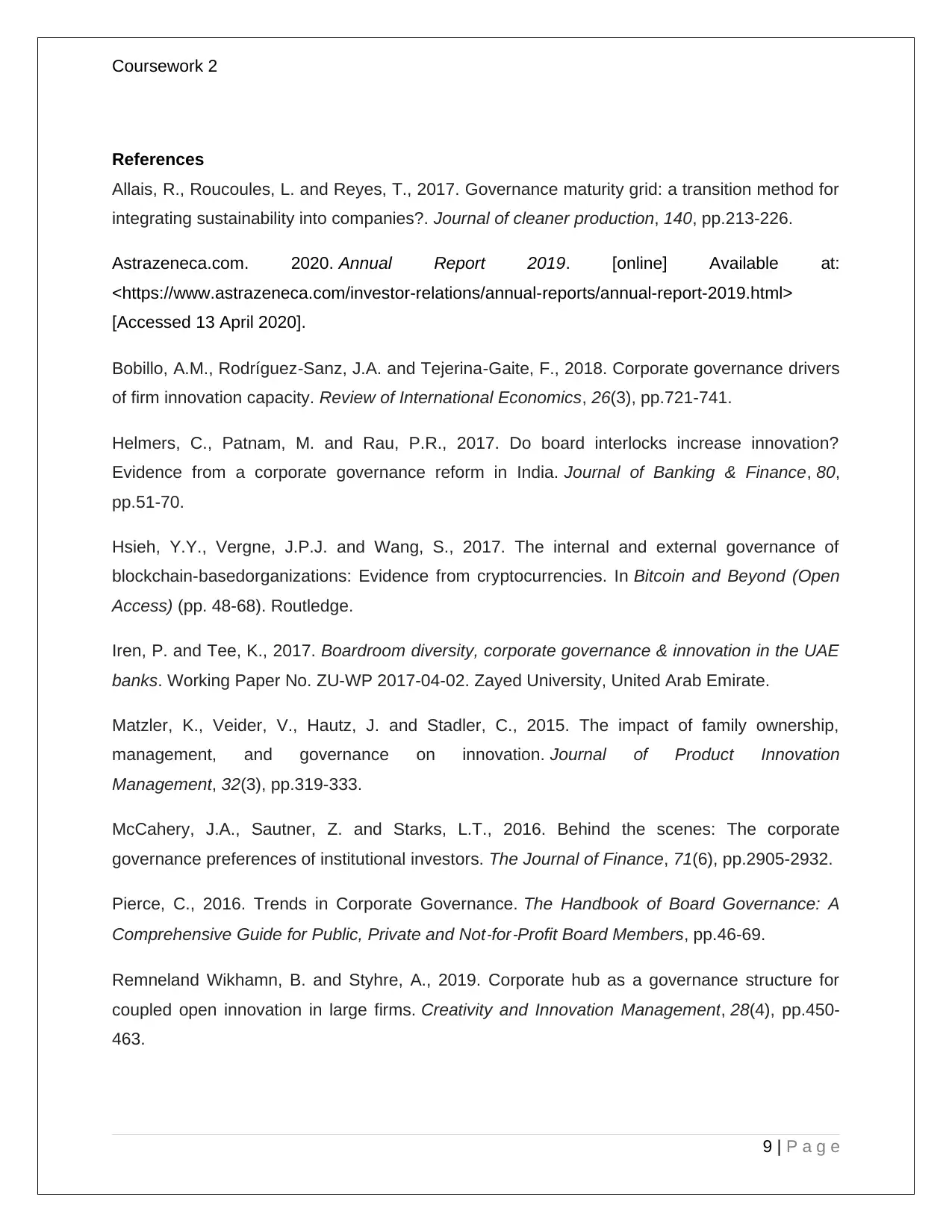
Coursework 2
References
Allais, R., Roucoules, L. and Reyes, T., 2017. Governance maturity grid: a transition method for
integrating sustainability into companies?. Journal of cleaner production, 140, pp.213-226.
Astrazeneca.com. 2020. Annual Report 2019. [online] Available at:
<https://www.astrazeneca.com/investor-relations/annual-reports/annual-report-2019.html>
[Accessed 13 April 2020].
Bobillo, A.M., Rodríguez‐Sanz, J.A. and Tejerina‐Gaite, F., 2018. Corporate governance drivers
of firm innovation capacity. Review of International Economics, 26(3), pp.721-741.
Helmers, C., Patnam, M. and Rau, P.R., 2017. Do board interlocks increase innovation?
Evidence from a corporate governance reform in India. Journal of Banking & Finance, 80,
pp.51-70.
Hsieh, Y.Y., Vergne, J.P.J. and Wang, S., 2017. The internal and external governance of
blockchain-basedorganizations: Evidence from cryptocurrencies. In Bitcoin and Beyond (Open
Access) (pp. 48-68). Routledge.
Iren, P. and Tee, K., 2017. Boardroom diversity, corporate governance & innovation in the UAE
banks. Working Paper No. ZU-WP 2017-04-02. Zayed University, United Arab Emirate.
Matzler, K., Veider, V., Hautz, J. and Stadler, C., 2015. The impact of family ownership,
management, and governance on innovation. Journal of Product Innovation
Management, 32(3), pp.319-333.
McCahery, J.A., Sautner, Z. and Starks, L.T., 2016. Behind the scenes: The corporate
governance preferences of institutional investors. The Journal of Finance, 71(6), pp.2905-2932.
Pierce, C., 2016. Trends in Corporate Governance. The Handbook of Board Governance: A
Comprehensive Guide for Public, Private and Not
‐for
‐Profit Board Members, pp.46-69.
Remneland Wikhamn, B. and Styhre, A., 2019. Corporate hub as a governance structure for
coupled open innovation in large firms. Creativity and Innovation Management, 28(4), pp.450-
463.
9 | P a g e
References
Allais, R., Roucoules, L. and Reyes, T., 2017. Governance maturity grid: a transition method for
integrating sustainability into companies?. Journal of cleaner production, 140, pp.213-226.
Astrazeneca.com. 2020. Annual Report 2019. [online] Available at:
<https://www.astrazeneca.com/investor-relations/annual-reports/annual-report-2019.html>
[Accessed 13 April 2020].
Bobillo, A.M., Rodríguez‐Sanz, J.A. and Tejerina‐Gaite, F., 2018. Corporate governance drivers
of firm innovation capacity. Review of International Economics, 26(3), pp.721-741.
Helmers, C., Patnam, M. and Rau, P.R., 2017. Do board interlocks increase innovation?
Evidence from a corporate governance reform in India. Journal of Banking & Finance, 80,
pp.51-70.
Hsieh, Y.Y., Vergne, J.P.J. and Wang, S., 2017. The internal and external governance of
blockchain-basedorganizations: Evidence from cryptocurrencies. In Bitcoin and Beyond (Open
Access) (pp. 48-68). Routledge.
Iren, P. and Tee, K., 2017. Boardroom diversity, corporate governance & innovation in the UAE
banks. Working Paper No. ZU-WP 2017-04-02. Zayed University, United Arab Emirate.
Matzler, K., Veider, V., Hautz, J. and Stadler, C., 2015. The impact of family ownership,
management, and governance on innovation. Journal of Product Innovation
Management, 32(3), pp.319-333.
McCahery, J.A., Sautner, Z. and Starks, L.T., 2016. Behind the scenes: The corporate
governance preferences of institutional investors. The Journal of Finance, 71(6), pp.2905-2932.
Pierce, C., 2016. Trends in Corporate Governance. The Handbook of Board Governance: A
Comprehensive Guide for Public, Private and Not
‐for
‐Profit Board Members, pp.46-69.
Remneland Wikhamn, B. and Styhre, A., 2019. Corporate hub as a governance structure for
coupled open innovation in large firms. Creativity and Innovation Management, 28(4), pp.450-
463.
9 | P a g e
⊘ This is a preview!⊘
Do you want full access?
Subscribe today to unlock all pages.

Trusted by 1+ million students worldwide
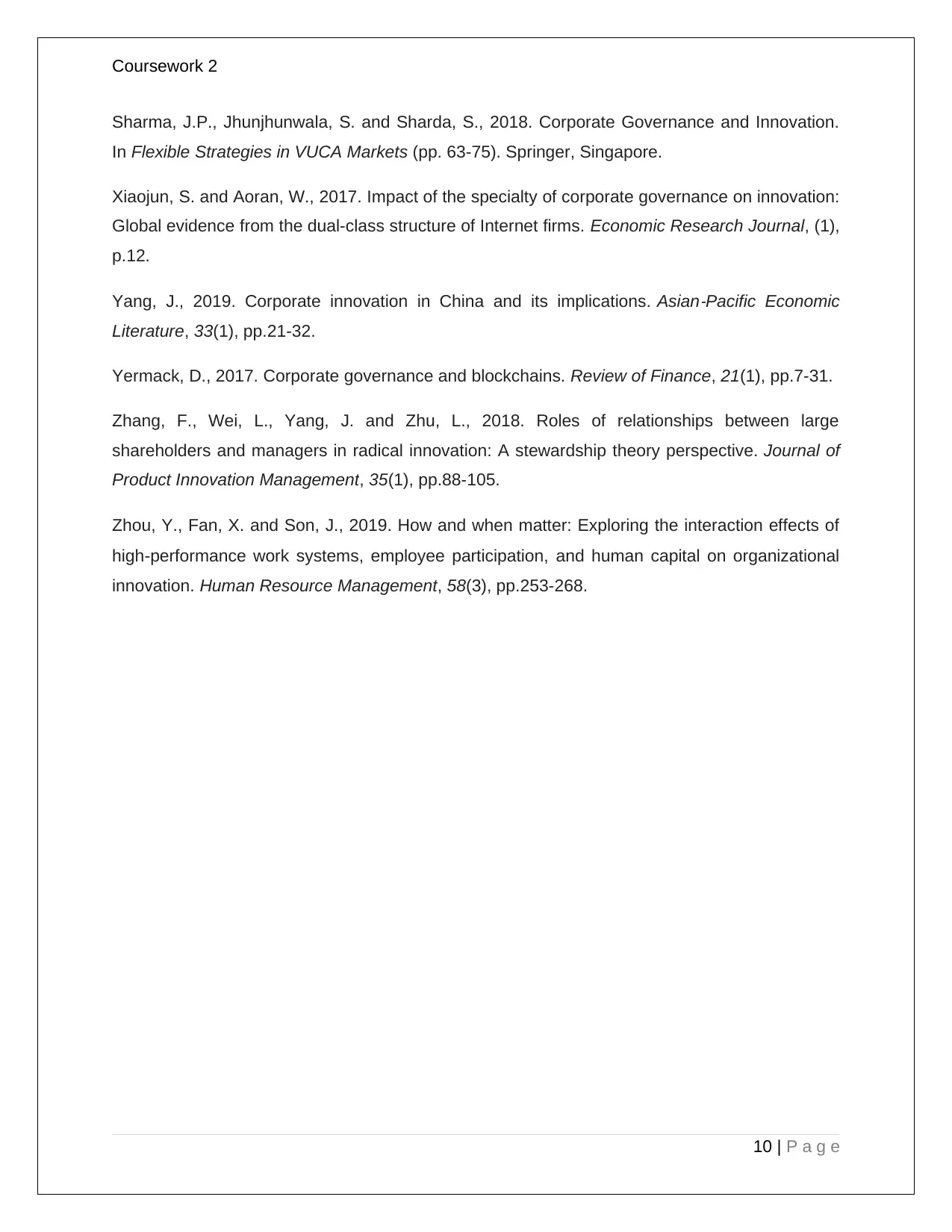
Coursework 2
Sharma, J.P., Jhunjhunwala, S. and Sharda, S., 2018. Corporate Governance and Innovation.
In Flexible Strategies in VUCA Markets (pp. 63-75). Springer, Singapore.
Xiaojun, S. and Aoran, W., 2017. Impact of the specialty of corporate governance on innovation:
Global evidence from the dual-class structure of Internet firms. Economic Research Journal, (1),
p.12.
Yang, J., 2019. Corporate innovation in China and its implications. Asian
‐Pacific Economic
Literature, 33(1), pp.21-32.
Yermack, D., 2017. Corporate governance and blockchains. Review of Finance, 21(1), pp.7-31.
Zhang, F., Wei, L., Yang, J. and Zhu, L., 2018. Roles of relationships between large
shareholders and managers in radical innovation: A stewardship theory perspective. Journal of
Product Innovation Management, 35(1), pp.88-105.
Zhou, Y., Fan, X. and Son, J., 2019. How and when matter: Exploring the interaction effects of
high‐performance work systems, employee participation, and human capital on organizational
innovation. Human Resource Management, 58(3), pp.253-268.
10 | P a g e
Sharma, J.P., Jhunjhunwala, S. and Sharda, S., 2018. Corporate Governance and Innovation.
In Flexible Strategies in VUCA Markets (pp. 63-75). Springer, Singapore.
Xiaojun, S. and Aoran, W., 2017. Impact of the specialty of corporate governance on innovation:
Global evidence from the dual-class structure of Internet firms. Economic Research Journal, (1),
p.12.
Yang, J., 2019. Corporate innovation in China and its implications. Asian
‐Pacific Economic
Literature, 33(1), pp.21-32.
Yermack, D., 2017. Corporate governance and blockchains. Review of Finance, 21(1), pp.7-31.
Zhang, F., Wei, L., Yang, J. and Zhu, L., 2018. Roles of relationships between large
shareholders and managers in radical innovation: A stewardship theory perspective. Journal of
Product Innovation Management, 35(1), pp.88-105.
Zhou, Y., Fan, X. and Son, J., 2019. How and when matter: Exploring the interaction effects of
high‐performance work systems, employee participation, and human capital on organizational
innovation. Human Resource Management, 58(3), pp.253-268.
10 | P a g e
1 out of 10
Related Documents
Your All-in-One AI-Powered Toolkit for Academic Success.
+13062052269
info@desklib.com
Available 24*7 on WhatsApp / Email
![[object Object]](/_next/static/media/star-bottom.7253800d.svg)
Unlock your academic potential
Copyright © 2020–2025 A2Z Services. All Rights Reserved. Developed and managed by ZUCOL.




